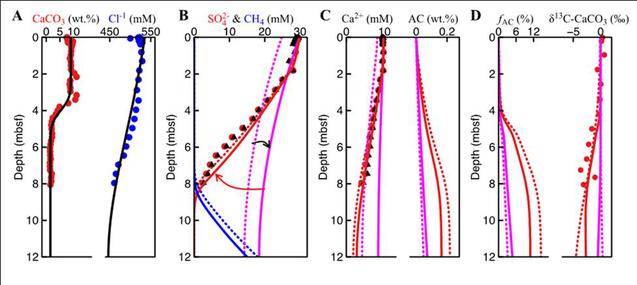Sinan Xu a b c, Bo Liu c, Zijun Wu a, Nicole Kowalski d, Michael Ernst Böttcher d e f
a State Key Laboratory of Marine Geology, School of Ocean and Earth Science, Tongji University, Shanghai 200092, PR China
b The Key Laboratory of Gas Hydrate, Ministry of Natural Resources, Qingdao Institute of Marine Geology, Qingdao, China
c Alfred Wegener Institute Helmholtz Centre for Polar and Marine Research, D-27570 Bremerhaven, Germany
d Geochemistry & Isotope Biogeochemistry Group, Department of Marine Geology, Leibniz Institute for Baltic Sea Research (IOW), D-18119 Warnemünde, Germany
e Marine Geochemistry, University of Greifswald, D-17489 Greifswald, Germany
f Interdisciplinary Faculty, University of Rostock, D-18059 Rostock, Germany
Abstract:
The formation and burial of authigenic carbonate in marine sediment significantly affect the sedimentary carbon cycle and its isotopic mass balance in geological history. Anaerobic oxidation of methane (AOM) is the primary driver of authigenic carbonate precipitation within the sulfate-methane transition zone (SMTZ). Quantitative estimations of the role of AOM on the authigenic carbonate precipitation and its carbon isotope under non-steady-state processes (e.g., changes in methane fluxes at the bottom sediment, sedimentation rates or organic fluxes in the surface sediment), however, are still limited. In this study, we use geochemical data from porewater (e.g., the concentration of sulfate, calcium, magnesium, strontium, dissolved inorganic carbon, total alkalinity) and solid sediment (e.g., organic matter content, and carbonate content) in different depositional environments of the subtropical Beibu Gulf, South China Sea, combined with a diagenetic reactive-transport modelling approach, to estimate the mineralogy of authigenic carbonate, the relationship between AOM and authigenic carbonate precipitation, and the impact of AOM rate on carbon isotope of sediment carbonate (δ13CCar). The results show that high-Mg carbonates (high-Mg calcite and dolomite) are the main type of authigenic carbonate (∼80%) formed in the methane-bearing sediments, leading to higher porewater Sr2+/Ca2+ (>0.02) and Mg2+/Ca2+ (>20) within the SMTZ. Our modelling analysis highlights that the non-steady-state induced by increased methane flux from the underlying sediments can significantly accelerate the authigenic carbonates formation within the SMTZ. Using parametric sensitivity analysis, we observed that even a 1% increase in the authigenic carbonate fraction of sediment carbonates results in significant changes in δ13CCar within the SMTZ (from −1‰ to −2‰), mainly due to lighter carbon isotopes produced by more intensive AOM processes. Noteworthily, the terrestrial-to-marine transition was identified by the sediment and porewater geochemical profiles at site SO-8. Although lower authigenic carbonate precipitation occurs in terrestrial sedimentary environments, the proportion of authigenic carbonate in terrestrial environments (11%) is much higher than that in marine environments (1%), resulting in carbon isotopes of carbonate in terrestrial sediments becoming more negative (−5‰).
Full Airticle:https://doi.org/10.1016/j.chemgeo.2023.121319


